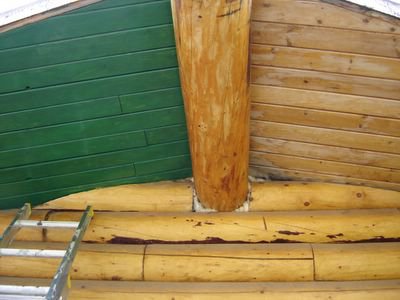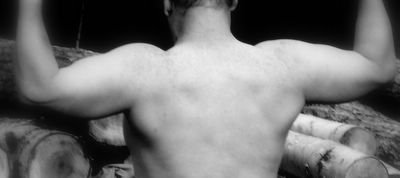"They think they're so high and mighty, just because they never got caught driving without pants." - Moe, The Simpsons

The Road Often Taken, by Robert "The Blonde Assassin" Frost
Driving in Alaska is riskier than wearing pork chop underwear in a room filled with terriers.
That's because, well, it's Alaska.
Only at the beginning and end of the winter are the roads especially slippery. Thatis because when the temperature plunges below zero, the freeze, thaw, freeze that makes the road slicker than a Clinton selling used cars: "I did not have sex . . . in that back seat."
I think people in most other locations have it worse when it comes to slick roads. The frozen snowpack up here actually does pretty well for traction, if you have a decent set of tires on your vehicle. Since it doesn't thaw, it doesn't get as slick. Nice.
What makes it a more treacherous than that sleazy little guy who won freshman class president at your high school is the defining factor of Alaska: the cold. The cold makes it more likely your vehicle will cease to function in the manner that you wish it to, namely, start running or keep running. Case in point, this morning.
I get up to go to work. A normal workday. I hadn't driven the car in several days. That's a good thing, since my car uses more gas than India. My car also uses electricity continually, through the anti-theft system and through the remote starter system. As I mentioned before, I park it outside. Given the recent intense low temperatures (-40F) at my place, the electrical systems drained the battery drier than a horsehide flagon of fermented mare's milk in Genghis Khan's summer house. And that's dry. You know how those Khan kids go after the mare's milk on their Frankenberry's.
So, I turn the key, and the clickety-click sound tells me that it's time to go buy the charger that will charge my battery whenever I have my block heater plugged in. That's just one example of the way the cold contributes to a myriad of auto failures, since Detroit rarely gets to -55F and things are different when it's cold.

Not only will this charger charge my car, but also, according to the legend, my jet-ski. Which is great, except that I don't have a jet-ski. Maybe the instruction manual will clarify if one comes with the charger.
This begs the question: If your car won't start or stops running, what then?
This is a very real and very dangerous situation that faces people in Alaska throughout the winter. The first answer is: don't be stupid. When I say, "Don't be stupid," I don't mean, "Don't be stupid and date that tramp Britney Spears," I mean "Don't be stupid and blow dry your hair while you're in the shower."
The first step starts with clothing. You have to know how far you're away from people. Doesn't matter if you know the people, they just have to be human beings. If you're in Alaska, and it's -55F out, they'll help. I guarantee it. So, if you're going to be two miles from the nearest person during your trip, well, dress for that twenty minute hike. If it's 10 miles, think harder. If it's more than that, pack for survival.
That starts with shoes, good ones, and ones that will keep the snow off of your ankles. If you've gone seriously back country (which, with The New Boy around we don't), well, snowshoes or Nordic skis might also be appropriate. I've got a pair of boots rated for, seriously, -100F. Normally, it's not that cold around the house unless I've forgotten an anniversary.
A good coat is nice, and layers are better. One of the most dangerous things in the winter is sweat - it cools you in the summer, but it will cause many fabrics (cotton especially) to lose any insulating ability whatsoever. Don't know about you, but running around in soaking wet clothing at -40F seems more dangerous than being a Twinkie at Roseanne Barr's house.
We mainly travel with a sleeping bag or two in the car when we're just out and about around traveled areas, it shouldn't be long until someone comes by. When we've gone to Anchorage in the winter, well, we've packed more for an expedition, with insulated coveralls and more extreme weather clothing and rudimentary survival gear. I'm not talking Everest-caliber stuff, but something that would let us live and keep most of our favorite toes (I like the littlest piggies best, you know, the ones that go wee-wee-wee allthewayhome).
The Mrs. wants me to get a locater beacon for my backcountry wanderings next year, and that makes sense. They don't cost all that much, they don't weigh all that much, and if you pull the pin, folks with hot soup and multi-million dollar helicopters can pull you and your broken leg out of a bad spot. I still think that my insurance is worth way more than me, but, she's got a soft spot in her heart. If I get one, that goes in the car with us when we do a long winter trip. By the way, don't count on cell phones - Alaska's cell coverage is less coverage than the typical Speedo covered guy on a European beach has.
Here's the real deal. Alaskans have been living in a harsh and dangerous climate for as long as people have been in Alaska. That, incidentally, is far longer than FEMA has existed, and much longer than FEMA has been useful for anything more than spending money by shoving it out of helicopter windows so people can burn it and warm themselves in the glow of hundred dollar bills.
The paradox is that most people in Alaska understand the dangers they face and act responsibly and accordingly as if no one can help them, yet I have never seen a place where people are as selfless and generous as Alaskans are. I've mentioned before that if you see a car by or off the road in winter, well, it's hard to be the first one to stop to help. I should know, since I've now had to resort to running old ladies driving Buicks off the wintry snow packed roads so I can get there first to help.

















 Blogarama
Blogarama